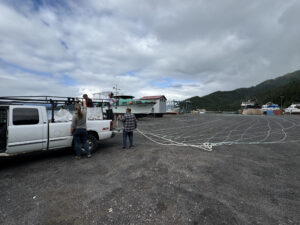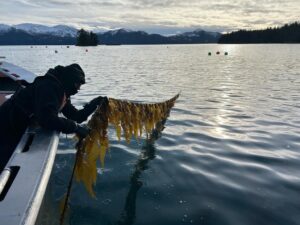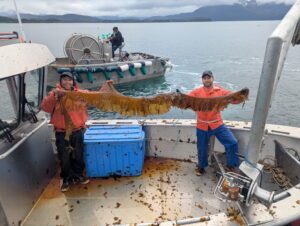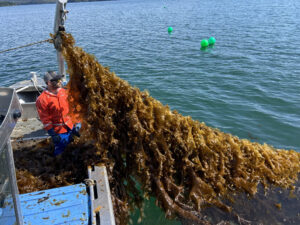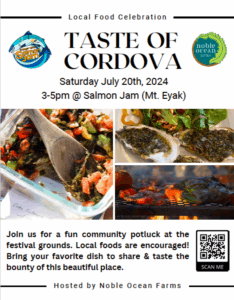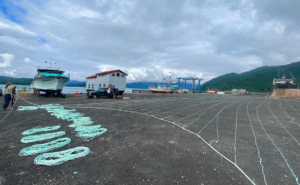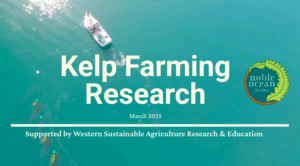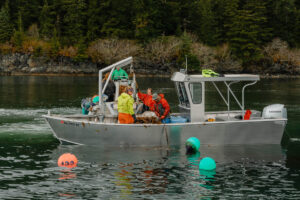Final report for FW23-415
Project Information
Kelp farming is a relatively new method of food production in Alaska, with the first commercial harvest in 2017. Kelp farming in the U.S. began with the deployment of a submerged horizontal line (rope) seeded with spores that grow to harvestable size in six months. The conventional single-line approach takes up a lot of ocean space and tends to sag deeper than desired. Without wide spacing between these lines, tangling can occur, causing loss of crop or damage to the lines.
In Prince William Sound, Noble Ocean Farm is one of three commercial farms growing kelp (seaweeds) for food. During the first season, these farms struggled to keep the underwater array system (anchors, lines, buoys, connection points) tensioned during large tidal fluxes. We experienced equipment failures and lower crop density compared to kelp farms in other areas. This is a common issue for kelp farmers in Alaska, most of whom are struggling to achieve profitability.
As the seaweed farming industry expands, it is important to optimize kelp growth per unit length of seeded line and per acre of farmed lease. Therefore, our research questions are: 1) How do we grow the most amount of kelp in the smallest footprint? And 2) What is the minimum amount of spacing allowable between lines?
Recently, our Technical Advisor, Clifford Goudey, developed novel 5-line and catenary arrays. These allow close line spacing, powerful tensioning to prevent tangling, and numerous other advantages over present practices including compatibility with more efficient, mechanized seeding and harvesting.
We have conducted a side-by-side comparison of a conventional single-line array, a 5-line array, and a 25-line catenary array. Our metrics have included: kelp growth per foot, ocean space used, costs, and array performance. This research has helped reveal the most efficient configuration and can inform current and future kelp farmers in their farm design decisions. Results are being shared via a workshops, farm tours, and fact sheets.
Research Objectives:
- Determine the efficiency of various kelp farm systems in producing kelp biomass.
- Characterize the pros and cons of kelp farming system options with respect to equipment, installation, monitoring, and labor costs vs. crop harvested.
- Compare monthly growth, quality, and end-of-season biomass harvests per foot and per acre among the farm systems tested.
Education Objectives:
- Inform present and aspiring seaweed farmers about opportunities in kelp farming.
- Explain farm system options and their pros and cons using a hand-on educational workshop.
- Show three different array systems to current and aspiring farmers, including early career mariculturists from the local and nearby communities.
- Create fact sheets to disseminate our research findings to kelp farmers throughout the entire Western United States via email and social media networks.
| Dates | Activities | Task | Team Members |
| August 1, 2024 | Team meeting | Project starts - ACCOMPLISHED | Melissa Skye Steritz (PI), Clifford Goudey (TA), Sean Den Adel |
| August-October 2024 | Build & install farm systems (arrays) before planting sugar kelp seed in October | Research Task 1 - ACCOMPLISHED | Sean Den Adel, Clifford Goudey (TA) |
| January-May 2025 | Monitor kelp growth on different array types & quantify efficiency of array types by comparing crop growth data & costs |
Research Tasks 2 and 3 - ACCOMPLISHED |
Melissa Skye Steritz (PI), Clifford Goudey (TA) |
| April-June 2025 | Determine pros & cons of array types | Research Task 4 - ACCOMPLISHED | Sean Den Adel, Clifford Goudey (TA) |
| February-March 2025 | Plan workshop in Cordova | Education Task 1 - ACCOMPLISHED | Melissa Skye Steritz (PI), Clifford Goudey (TA), Sean Den Adel |
| February-March 2025 | Invite stakeholders to workshop | Education Task 2 - ACCOMPLISHED | Melissa Skye Steritz (PI) |
| March 2025 | Host workshop in Cordova with online option | Education Task 3 - ACCOMPLISHED | Melissa Skye Steritz (PI), Clifford Goudey (TA), Sean Den Adel |
| March 2025 | Perform targeted outreach for farm tour | Education Task 4 - ACCOMPLISHED | Melissa Skye Steritz (PI) |
| April 2025 | Facilitate farm tour | Education Task 5 - ACCOMPLISHED | Sean Den Adel, Melissa Skye Steritz (PI) |
| May-June 2025 | Develop factsheet | Education Task 6 - ACCOMPLISHED | Melissa Skye Steritz (PI), Clifford Goudey (TA) |
| June-August 2025 | Distribute factsheets | Education Task 7 - ACCOMPLISHED | Melissa Skye Steritz (PI) |
| August 2025 | Project reporting & submission | Project conclusion - ACCOMPLISHED | Melissa Skye Steritz (PI) |
Cooperators
- - Producer
- - Technical Advisor
Research
Research Objectives:
- Determine the efficiency of various kelp farm systems in producing kelp biomass.
- Characterize the pros and cons of kelp farming system options with respect to equipment, installation, monitoring, and costs vs. crop harvested.
- Compare monthly growth, quality, and end-of-season biomass harvests per foot and per acre among the farm systems tested.
We met our research objectives using the following steps:
Research Task 1: Installation and seeding of test arrays
In the Noble Ocean Farms’ 22-acre aquatic farm lease, we installed three different types of kelp farm array systems side by side for comparison: one conventional single-line array, novel 5-line array, and a novel 25-line catenary array. Noble Ocean Farms has a 10-year lease through the Alaska Department of Natural Resources. This site is in the western arm of Simpson Bay in Eastern Prince William Sound.
Throughout this proposal the term array means a farming system that supports neutrally buoyant grow lines at a specific depth below the surface, supported by surface floats and held in position by other lines and anchors.
12,200 feet total of native sugar kelp was seeded on horizontal suspended grow lines in the fall of 2024. This total amount accounts for all three array types. During our planting in October of 2024, the grow lines on the arrays were carefully and tightly wrapped with kelp seed string containing thousands of tiny kelp sporophytes. The holdfasts (roots) of the kelp now seems to have transferred from the seed string and attached directly to the grow lines. We observed more productivity (longer kelp blades) during the month of February than seen before.
The three different array types were rigged with 200’ and 400’ grow lines, and aligned with the dominant tidal currents in Simpson Bay. Cross-sectional and design views of each array type are shown in the attachment "Maps and Figures" within the Other Documents section, along with site maps.
The single-line array was spaced according to normal practice, which is 40’ from any neighboring arrays and aligned with the dominant tides. This is the most common, straightforward design for growing kelp in the United States, yet farmers have struggled with tensioning, efficiency, and productivity using this conventional single-line design. The single-line array performed amazingly well, with denser growth than the two other array types.
The 5-line arrays were fitted with two 10’ aluminum end spreader bars and one mid-line spreader bar, with the grow lines spaced 2.5’ apart. The design of the 5-line array expands on the basic single-line approach, incorporating aluminum spreader bars that allow precisely measured grow lines to be used in close proximity without tangling or overlapping. Spreader bars theoretically can enhance the productivity of the farm by allowing farmers to seed kelp on more grow lines using the same or even less ocean space. Additionally they allow farmers to save money on anchors because you can deploy multiple grow lines using two anchors, rather than deploying a single-line array, also using two anchors. The idea is to boost the growing capacity without increasing the site footprint. One of our 5-line arrays performed quite well, while the other performed poorly (due to seed quality issues).
The catenary array is by far the largest of the three array designs, with a width of 75’ and including a total of 25 grow lines, spaced 3’ apart. Each of these grow lines are 400' long, composed of two 200' long sections joined end-top-end. This array type allows farmers to use more grow lines than other approaches and creates easier underwater tensioning that ensures tension uniformity across the farm. A curved horizontal line is used as the catenary framing line. This secures grow lines to the anchor system. The grow lines are pretensioned with equal force and precisely measured before installation. The catenary array is designed to benefit farmers by increasing productivity per area, profitability and efficiency.
The farm systems were installed by Noble Ocean Farms’ partner team: Melissa Skye Steritz and Sean Den Adel. Seeding of all grow lines utilized seed spools from the Alutiiq Pride Marine Institute in Seward, Alaska. Once seeded, the systems were tightened to provide the level of pre-tension needed to control vertical sag, keeping all grow lines to the optimal 6’ of submergence.
This task was led by Sean Den Adel at Noble Ocean Farms with the technical advice from Clifford Goudey and using key farm supplies provided by TendOcean™.
Research Task 2: Determination of the installation and operational efficiency of various kelp farm array systems
We have finished compiling our data, including costs of equipment, supplies, and labor associated with each array system. This includes the entire course of the kelp season, from installation, through harvest, and including seasonal gear removal. Hours of labor required to build, install and maintain each individual farm system were recorded, so future farmers know how labor efficiency varies based on design.
This data collection and complication task was led by Melissa Skye Steritz at Noble Ocean Farms with the technical advice from Clifford Goudey.
Research Task 3: Measurement of the kelp growth, quality, and end-of-season biomass harvests
All systems and grow lines were checked on a monthly basis to maintain pretension, measure growth, and evaluate the performance of each system with respect to grow line interactions and the presence of any inter-line tangles. We recorded data during each farm monitoring visit.
As the crop grew, parameters including stipe (stalk/stem) counts per foot of grow line, average stipe lengths, average blade (leaf) lengths and the presence of any competing organisms were recorded.
This task was led by Melissa Skye Steritz at Noble Ocean Farms with the technical advice from Clifford Goudey.
Research Task 4: Characterization of the pros and cons of kelp farming array system options tested
The results of Tasks 2 & 3 were used to determine the efficiency of each type of farm system based on harvested pounds vs. the associated costs.
This task was led by Sean Den Adel at Noble Ocean Farms with the technical advice from Clifford Goudey.
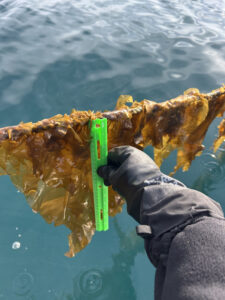
Research Task 1 and 2: Results of installation, seeding and operational efficiency of various kelp farm array systems
|
|
Amount of Time for 2 People Working |
|
Single-Line Array |
|
| Build/assembly time |
8 hours of labor for 2 people |
|
Installation/deployment time |
4-6 hours for 2 people |
|
5-Line Array |
|
|
Build/assembly time |
12-16 hours of labor for 2 people |
|
Installation/deployment time |
6-8 hours for 2 people |
|
Catenary Array |
|
|
Build/assembly time |
N/A Purchased as a commercial product. |
|
Installation/deployment time |
12-16 hours for 2 people |
Research Task 3: Measurement of the kelp growth, density, and end-of-season biomass harvests
|
|
Average Blade Length |
Average Stipe Length |
Stipes per Foot (Density) |
|
Single-Line Array |
|
||
|
Halfway Through Season |
16 inches |
1.5 inches |
72 |
|
End of Season |
8 feet 2 inches |
2.4 inches |
70 |
|
5-Line Array |
|
|
|
|
Halfway Through Season |
14 inches |
1.2 inches |
120 |
|
End of Season |
8 feet |
2.2 inches |
116 |
|
Catenary Array |
|
|
|
|
Halfway Through Season |
11 inches |
0.9 inches |
36 |
|
End of Season |
7 feet 6 inches |
1.8 inches |
35 |
Our greatest achievement in the past year was enhancing our farm’s productivity nearly 10-fold by implementing new cultivation methodologies. By using novel array systems and increasing the number of kelp sporophytes planted, we produced by far the most kelp we ever had. Previously, our largest harvest was 3,740 lbs. This year, our total kelp harvest was 30,525 lbs!
At harvest time, the total biomass from the harvested crop from each grow line was weighed to determine the average harvested biomass per foot of line on each array. Those numbers are recorded in the table below.
| Array | Total Harvested Biomass | Total Length of Growlines | Average Biomass Per Foot |
| Single-line array | 1,158 lbs. | 200 ft. | 5.79 lbs./ft. |
| 5-line array #1 | 928 lbs. | 1,000 ft. | 0.93 lbs./ft. |
| 5-line array # 2 | 5,629 lbs. | 1,000 ft. | 5.63 lbs./ft. |
| Catenary array | 22,810 lbs. | 10,000 ft. | 2.28 lbs./ft. |
Interestingly, the catenary and 5-line systems had variable growth from line to line. Some of the lines have succeeded with amazing productivity, while others produced relatively little kelp. The most biofouling occurred on the catenary growlines that had poor seed, as the spotty kelp sporophytes were out-competed by other, unwanted algae and invertebrates.
Research Task 4: Characterization of the pros and cons of kelp farming array system options tested
|
Gear costs below assume depth of 80 ft. |
||
|
Total Gear Cost |
Cost of Gear per Foot of Growline |
|
|
Single-Line Array |
$4,696.32 + shipping |
$11.74/ft. |
|
5-Line Array |
$7,557.80 + shipping |
$7.56/ft |
|
Catenary Array |
$26,120.07 + shipping |
$2.61/ft. |
Our greatest challenge this year was the variability of seed quality available to us. We believe the main factor affecting the variable productivity of array systems was the seed we started with. Throughout the season, when we measured growth rates on a single marked line with similar seed quality from each array, we saw more uniform numbers. However, when we averaged the biomass per foot at the end of the season is where we got the big fluctuations because some lines on the catenary had much better seed than others. The same was true with the 5-lines.
As farmers, we have to rely on a nursery growing our kelp sporophytes before they can be planted on the farm. As we cannot control the conditions of their nursery, we have to trust the process. There is a high risk of contamination from other algae, as they have to use seawater pumps coming from the ocean. We learned this year that the filtration systems can be very troublesome, and we need to find ways to support the nurseries in our region to enhance their filtration systems, so we can receive consistently high quality kelp seed.
In the end, we can conclude that the catenary is the most cost-effective array type, per foot of line, allows the seeding of the most grow lines per acre of lease, uses fewer anchors per length of growline, and has the ability to produce at least as much biomass as any other array when starting with consistently high-quality seed. Therefore, the catenary array will most likely be the best option for kelp farmers with a couple years of experience. It is also worth noting that the catenary modules can be stacked side-top side or end-to-end with very low incremental cost compared to the initial array. As the Alaska kelp sector grows in scale, the catenary array may prove to be the enabling technology.
Below are our notes on assembly, deployment, and maintenance of each array type, as well as overall challenges and benefits of utilizing each within a kelp farming operation. These observations can help inform current and future farmers' investments in gear choices.
Single-line Array
| Assembly & Deployment Notes | Maintenance Notes | Advantages/Benefits |
| Easy to build and deploy | Easy to monitor | The single-line array has the lowest upfront costs and is a great option for early efforts at a new farm site. |
| Requires only two anchors - can usually be done with a smaller boat than larger arrays require. | Straight-forward to adjust tension as well as to maintain tension and desired growline depth. | It is best used to determine site suitability for a desired species without investing in a larger system. |
5-Line Array
| Assembly & Deployment Notes | Maintenance Notes | Advantages/Benefits |
| Welded spreader bars are expensive and require some engineering. | Spreader bars need to be cleaned of unwanted growth periodically. | Easy to tension and inspect as tensioning one anchor line effectively tensions five growlines. |
| Spreader bars are also awkward and cumbersome to deploy and remove. | Once deployed, it is easy to tension lines suspended between the spreader bars. | Close line spacing helps farmers more efficiently utilize acreage of an aquatic farm lease. |
Catenary Array
| Assembly & Deployment Notes | Maintenance Notes | Advantages/Benefits |
| Requires engineering knowledge to build. | Can be challenging to inspect and maintain grow line depth if not properly tensioned. | Close line spacing helps farmers fully utilize an aquatic farm lease and produce maximum crop yields. |
| Heaviest system due to array size -- requires crane to move brailer bag onto boat for deployment | With so many lines closely spaced, it requires careful note-taking and ways of marking lines for growth monitoring, etc. | Very well-tensioned system when installed and maintained properly. |
Research Outcomes
Recommendations for Kelp Farmers:
- When starting a kelp farm for the first time, it is wise to begin with a single-line approach. You can test a new site and learn the basics of farming without investing too much money into gear. This is a great way to start.
- During your second year of kelp farming, we recommend adding at least one 5-line array. Our 5-line arrays used three aluminum spreader bars that allow you to enhance the productivity of the farm. You seed kelp on five times more grow line using the same amount of ocean space. Additionally, you will save money on anchors because you are still only using two anchors, like with a single-line array, but you boost the growing capacity, again with 5x more lines. This is the next step to increase productivity without increasing the site footprint.
- Once you have at least two years of ocean farming experience, we recommend upgrading to a catenary array. It is important to work with an engineer when designing your catenary array because there is a specific mathematical formula/hyperbolic function to follow to ensure uniformity of growline tension across the array. The grow lines must be precisely measured and pretensioned with equal force, something that occure4s with a properly designed catenary system. When they are deployed in the water, they run parallel to one another and can be spaced as little as 2.5 feet apart. The catenary array is designed to benefit farmers by increasing productivity per area, profitability and efficiency. It is ultimately the most cost-effective option for kelp farmers because:
-
- You can optimize your lease/acreage/ocean space more than you can with the single-line or 5-line approach.
- You can use fewer anchors per foot of growline than with a single-line or 5-line system. For a single-line, you will use two anchors for only one growline, whereas with a catenary, you will use eight anchors for 50 growlines.
- When installed and maintained correctly, the catenary allows for a high level of tension, producing great crop yields.
-
*Note: To reiterate, there are many variables that impact productivity levels when kelp farming, but we believe that high levels of productivity start with consistently high-quality seed spools. You need to have densely-packed, healthy kelp sporophytes on every spool when planting to achieve the best harvest possible with your gear. In our region, we have struggled to achieve this, which has impacted productivity of our kelp farming arrays.
Education and Outreach
Facilitated hands-on experience building kelp arrays
Participation Summary:
Education Objectives:
1. Inform present and aspiring seaweed farmers about opportunities in kelp farming.
Throughout the project, we have been informing present and aspiring seaweed farmers about the three array types we are using this growing season, including reporting to the GreenWave Farmer Cohort our challenges and successes associated with gear work/array preparation, deployment, and maintenance. For example, we had challenges installing the aluminum spreader bars of the novel 5-line system, so we shared that within the group.
We also did a kelp farmer knowledge exchange with Alaska's kelp farmers on Kodiak Island, where we simultaneously learned and shared opportunities to improve growing systems, harvesting methods, and stabilization techniques. Additionally, we have monthly check-in meetings with our regional kelp farmer cohort to discuss new opportunities for collaboration and improvement. We regularly discuss what is working and what is not working on each of our farms and problem solve together.
2. Explain farm system options and their pros and cons using a hand-on educational workshop.
We held our educational kelp farming workshop on March 25th, 2025 at the Prince William Sound Science Center. We created PowerPoint slides for this workshop and facilitated an informative community discussion about kelp farming.
3. Show three different array systems to current and aspiring farmers, including early career mariculturists from the local and nearby communities.
We are currently planning for our farm tour(s) to take place in April. It will probably be two different dates, with 4-6 people on each farm tour in order to allow for more a safe and in-depth experience. In March, we will perform targeted outreach for our April farm tours. We will invite both current and future Cordova-based farmers as well as those in neighboring communities within Prince William Sound.
4. Create fact sheets to disseminate our research findings to kelp farmers throughout the entire Western United States via email and social media networks.
This will be our final educational task -- synthesizing and analyzing all of the data from the three array types, creating an accessible/digestible factsheet, and performing dedicated outreach to disseminate the factsheet that summarizes our finding and recommendations. This will be completed by June/July 2025.
Effective Ways we Engaged with Community Stakeholders to Share Information:
Taste of Cordova 2024: We began educational and outreach activities in the summer of 2024. We taught local and regional community members about the nutritional benefits of sea vegetables, like kelp, and mariculture in general. We hosted a community potluck called "Taste of Cordova" in order to celebrate local foods and help people understand the different ways that sea vegetables can be consumed in delicious and nutritious dishes. There was quite a bit of engagement, with at least 12 people bringing homemade dishes and more than 100 people participating in the educational tasting event.
Hands-On Array Set-Up Training: In the fall of 2024, we invited local current and prospective farmers as we built our three array systems. We invited six people, so they could gain hands-on experience connecting grow lines together and assembling the array structures. Through this experience, they will know how to set up their own farm arrays in the future.
"Diving into Kelp" Workshop: We successfully hosted our “Diving Into Kelp Workshop” for our community on March 25th at the Prince William Sound Science Center. There were 23 participants in attendance in person and six more people online. During this workshop, we explained each of the three different kelp farming gear configurations that we are using, in detail. Additionally, we presented data on:
-
Average number of stipes/stems per foot
-
Average length of blades
-
Average length of stipes/stems
-
Amount of time it takes to construct each array on land
-
Amount of time it takes to install/deploy each array in the water
-
Cost of gear per foot of kelp growing line
-
Complications of each array system
In this presentation, we outlined our key takeaways of utilizing each gear type and answered participants’ questions about how they work. It was a great workshop, with lots of valuable conversation, knowledge transfer, and skill sharing.
Farm Tours during Harvest Season: In April and May, we explained the arrays pros and cons in person during three different educational kelp farming tours to show the three arrays in action to a total of 16 interested stakeholders. During these tours, there were mostly women stakeholders onboard and there were also two Alaska Native Elders. One of them is already involved in kelp farming and the other expressed wanting to get involved after his trip to our farm.
We compared the conventional kelp growing array system with two novel systems to identify which gear configuration is best suited to withstand large tidal fluxes (maintain tension) while growing the most kelp. We monitored kelp growth on the farm by pulling up the lines and measuring the growth.
Throughout the season, there were approximately 30 people who got to learn about kelp farming gear/array types, planting, harvesting, and processing this year. The processing of kelp was another interesting component for stakeholders to learn about, as we recently helped set up a new processing line in Cordova using a shredder, IBC totes, and citric acid to stabilize our kelp crop before being shipped to market. Our kelp is going to be used as a biostimulant/liquid extract to support the growth of food crops on land, enhancing food security without chemical fertilizers. 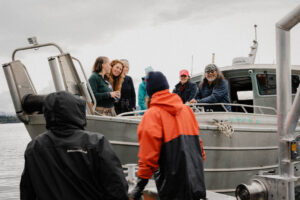
Education and Outreach Outcomes
Our project effectively disseminated agricultural research results through a combination of community-based outreach, multisensory education, and digital dissemination of summarized results. We prioritized accessibility and inclusivity, using hands-on demonstrations, visual aids, interactive workshops, and storytelling to bring in stakeholders and audience members from diverse backgrounds within our community.
We found that it's very important to inspire and educate people of all different age groups in order to sustainably develop this new kelp farming industry in Alaska. That starts with the youth. I started bringing my kelp enthusiasm into elementary school classrooms, beginning with 4th and 5th grades at Mt. Eccles Elementary. I offered students an overview of the unique opportunities we have to grow highly-nutritious and culturally-significant sea vegetables right in our own backyard – the bays of Eastern Prince William Sound.
The students responded with great curiosity, asking thoughtful questions and coming up with their own innovative ways to improve farming arrays. Students brainstormed and illustrated ideas for using boat rigging to create new gear deployment strategies and harvesting techniques. Next I facilitated hands-on kelp experiments in 2nd grade. I brought in some sugar kelp we grew on our farm and taught them about the structure of various seaweeds, including the holdfast, blade, and stipe. Students made observations of the kelp when it was fresh and raw, producing some cool pastel art pieces in the process! I think it's important to weave science and art to keep children engaged.

I then discussed the procedures of the forthcoming experiment and taught them about writing hypotheses. Next, they all formulated their own hypotheses about what they thought would happen when we put the raw kelp into the boiling water, prompting them with the question: “If we put the kelp in boiling water, what might change?”
After that came the really fun part: doing the science experiment and observing the changes! When we put kelp in boiling water, the heat broke down the brown pigments (took away the brown color of the raw kelp). Only the green chlorophyll remained. I explained that: “Chlorophyll is responsible for the green color of many plants and algae, like kelp. Chlorophyll’s job in a plant is to absorb light—usually sunlight. The energy absorbed from light is used in photosynthesis.” We reviewed what “photosynthesis” is: “the process of how plants make their own food. Every plant uses air, water, and sunlight to make its own food. They make glucose, a type of sugar, that allows them to grow” (National Geographic Education, 2024).
Students were fascinated by the chlorophyll connection between marine macroalgae and land plants. The interesting thing about kelp is that every single cell in the seaweed is capable of photosynthesis, versus land plants, in which only the green parts can create glucose. We then discussed different ways that kelp can be used in the kitchen and all of the fabulous nutritional benefits it has for our own bodies.

Working with our Food Services Director, Sandie Ponte, we were able to get kelp onto students’ plates after some rigorous testing and careful preparation. I gave each lunch period a quick presentation about kelp before they tried it as salsa verde on top of their cheesy nachos. Students certainly enjoyed the experience, and it was just the beginning of recipe development for incorporating these locally-grown sea vegetables in school lunches.
In the coming years, I would also love to get grants to bring students to the kelp farm and facilitate students growing native seaweed species in a tumble culture tank in their own classroom!
During our workshop, we hosted five Alaska Native participants, who live in our community. Most of them are people who have fished their entire lives, and made a living from commercial fishing. Now, they are looking at ways they can diversify their families’ incomes. Kelp farming is of interest, as it utilizes many of the assets their families have already have for working on the water. During the workshop, they asked us questions about the permitting process and options for setting up kelp farms. This knowledge transfer will enable them to make more informed decisions in the process. The relationship building component of the workshop was also important, so they now have our contact information if they need help with anything. We also helped one prospective Native farmer learn hands-on skills for array building.
By engaging multiple generations—from youth to elders—we fostered cross-generational dialogue to build understanding about sustainable kelp farming practices and how they can benefit our community.
Other current kelp farmers, as well as prospective farmers, gained knowledge in the technical skills needed to build, deploy, maintain, and harvest kelp farming arrays. There are local farmers who are now experimenting with new techniques.
Several community members, who are currently commercial fishermen, reported increased awareness, more positive attitude towards economic diversification, and enhanced interest in kelp farming methods after attending our workshop.
